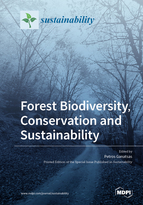Forest Biodiversity, Conservation and Sustainability
A special issue of Sustainability (ISSN 2071-1050). This special issue belongs to the section "Environmental Sustainability and Applications".
Deadline for manuscript submissions: closed (30 November 2019) | Viewed by 37262
Special Issue Editor
Interests: forest ecology; silviculture; ecological restoration; biodiversity conservation
Special Issues, Collections and Topics in MDPI journals
Special Issue Information
Dear Colleagues,
Forests demonstrate a high degree of biodiversity, being thought to comprise the most diverse ecosystems on land, as most of the terrestrial species in the world dwell there. Forest biodiversity is interlinked to a web of other socio-economic factors, providing an array of goods and services that range from timber and non-timber forest resources to mitigating climate change and conservation of genetic resources; therefore, it is innately linked to ecosystem and human well-being. However, forest biodiversity decrease is a crucial and ongoing environmental issue last decades. This Special Issue on Forest Biodiversity (FB) will include emerging issues for understanding FB and its conservation, such as ecological processes, disturbances, climate change and ecosystems resilience, structural complexity and ecosystem functions, ecological theories and silvicultural practices, and stability of FB. It will also include papers that focus on the indicators and methods for assessing and monitoring forest biodiversity, evaluation of practices, silvicultural treatments and management methods aiming at biodiversity conservation, conservation of forest biodiversity in protected areas, treatments of endangered or threaten forest habitats, and sustainable management of forest resources.
The continuing issue Forest Biodiversity, Conservation and Sustainability – Series II is opening for submission now.
Prof. Dr. Petros Ganatsas
Guest Editor
Manuscript Submission Information
Manuscripts should be submitted online at www.mdpi.com by registering and logging in to this website. Once you are registered, click here to go to the submission form. Manuscripts can be submitted until the deadline. All submissions that pass pre-check are peer-reviewed. Accepted papers will be published continuously in the journal (as soon as accepted) and will be listed together on the special issue website. Research articles, review articles as well as short communications are invited. For planned papers, a title and short abstract (about 100 words) can be sent to the Editorial Office for announcement on this website.
Submitted manuscripts should not have been published previously, nor be under consideration for publication elsewhere (except conference proceedings papers). All manuscripts are thoroughly refereed through a single-blind peer-review process. A guide for authors and other relevant information for submission of manuscripts is available on the Instructions for Authors page. Sustainability is an international peer-reviewed open access semimonthly journal published by MDPI.
Please visit the Instructions for Authors page before submitting a manuscript. The Article Processing Charge (APC) for publication in this open access journal is 2400 CHF (Swiss Francs). Submitted papers should be well formatted and use good English. Authors may use MDPI's English editing service prior to publication or during author revisions.
Keywords
- Ecological processes and forest biodiversity
- Forest biodiversity, climate change and ecosystems resilience
- Indicators and methods for assessing and monitoring forest biodiversity
- Ecological theories and silvicultural practices
- Silvicultural treatments aiming at biodiversity conservation
- Methods for conservation of forest biodiversity in protected areas
- Structural complexity and ecosystem functions
- Treatments of endangered or threaten forest habitats
- Sustainable management of forest resources
- Conservation and sustainable use of forest biodiversity






